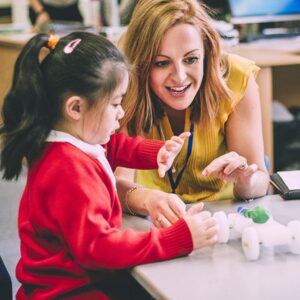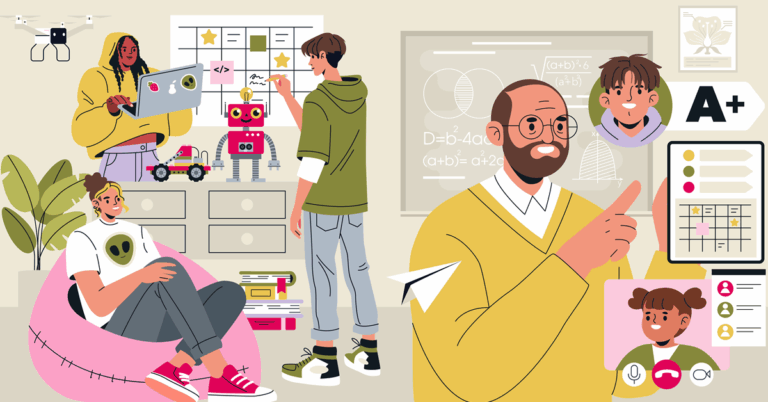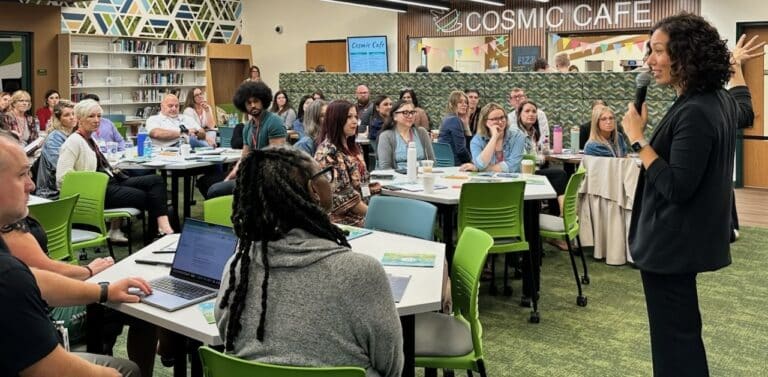A high school graduate in 2020 must be prepared to navigate a changing economy. They’ll need to be resourceful, willing and able to take the initiative and work collaboratively with others. Throughout their career they may need to reskill, take calculated risks and learn to thrive in ambiguity. The key to their success will not only be a strong academic foundation, but also the development of core future-focused, social-emotional learning skills that will prepare them for whatever path they choose.
What is social-emotional learning (SEL) and are there other terms that mean the same thing?
In our work with learning communities, we rely on the definition the Collaborative for Academic, Social and Emotional Learning (CASEL) developed, which states that social-emotional learning is the process through which children and adults acquire and effectively apply the knowledge, attitudes and skills necessary to understand and manage emotions, set and achieve positive goals, feel and show empathy for others, establish and maintain positive relationships and make responsible decisions. SEL may be referred to as 21st century skills, soft skills, employability skills or non-cognitive skills.
What are examples of commonly integrated SEL skills?
As KnowledgeWorks considers what students will need to thrive in an uncertain future, we’ve elevated self-awareness and emotional regulation, empathy and perspective-taking and cultivating a deep self-knowledge. We treat SEL as we would math or science competencies, identifying specific strategies and resources to support students in demonstrating mastery.
In the classroom or incorporated into a learning continuum, SEL might look like collaboration, creative approaches to problem-solving, critical thinking, demonstrating a growth mindset, communicating clearly, impulse control and others. Each learning community will identify those skills that resonate most with their hopes for graduates in their community, but all SEL skills will aid in building a foundation for successful lifelong learning.
How should districts determine which SEL skills to emphasize to ensure student success?
Whether SEL skills are identified during a learning community’s visioning process, named in their guiding principles or elevated in a district’s Portrait of a Graduate, a core set of SEL skills should be agreed upon by stakeholders throughout the community, including students, educators and parents. Every learning community is different, and the needs and desires of individuals within the community are just as diverse.
Identifying the SEL skills you want most to see cultivated in learners can be done through conducting community and parent surveys, creating regular opportunities for feedback and meeting stakeholders where they are – from attending community festivals to conferences in the classroom.
Do educators need specific training to integrate SEL into instruction?
Just as SEL must be integrated for learners, it must be integrated for educators, too. To prepare students for an emerging world of work, educators will need to understand and integrate programming into their instruction that emphasizes critical postsecondary and workforce readiness skills such as collaboration, critical thinking, communication, creativity and persistence.
When designing curriculum and considering a learning continuum, SEL should be aligned to academic outcomes, ensuring that they are being taught in context, as opposed to an add-on. Educators need to be able to get creative with how SEL is being incorporated into their instruction, including leveraging the opportunities students have in afterschool programs, sports and clubs to cultivate some of the skills they hope to see in the classroom. Providing teachers the time and support they need to make these connections, offering continuous professional development on strategies to identify, plan for, teach and assess SEL competence are critical.
How do we measure growth and mastery of SEL?
Organizations and educators throughout the field are working to develop high-quality assessment tools that will provide an accurate measurement of student growth and mastery of SEL, such as the Establishing Practical Social-Emotional Competence Assessments of Preschool to High School Students project.
But many districts are currently acquiring this data through in-classroom observation, student goal-setting and student self-assessment. Educators may develop a rubric that allows them to record instances of a student demonstrating competency or modeling a particular skill or behavior. Because SEL is integrated into the learning continuum, it does not take away from time spent on content and is measured alongside traditional academic metrics.






